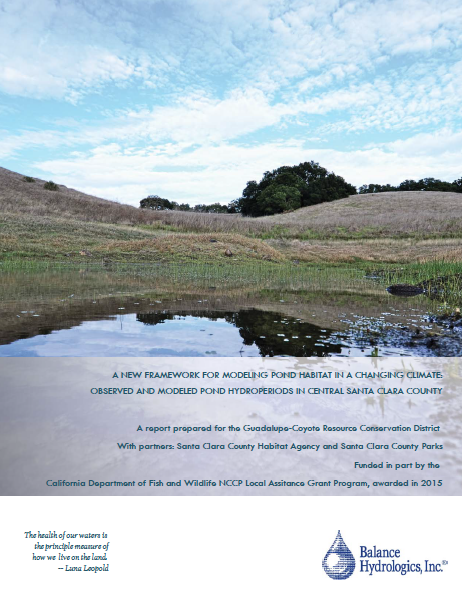Pond-IT
Pond-IT is an open-source water balance model for management of ponds and wetland habitat that developed by Balance Hydrologics through a California Department of Fish and Wildlife (CDFW) grant awarded to the District. Pond-IT stands for "Pond Inundation and Timing". The goal of the Pond-IT model platform is to provide land managers with the tools to evaluate existing pond resources, explore climate change impacts, and simulate possible low-cost habitat enhancement scenarios.

The model is available as both an Excel workbook and Python notebooks. Pond-IT was originally developed as a tool to easily model pond inundation period (or hydroperiod) of existing stock pond habitats and help land managers adapt hydroperiod to support target species (e.g. California Red-legged Frog, Western Pond Turtle and California Tiger Salamander) and to manage for invasive bullfrog populations which thrive in perennially-wetted habitats. Improved understanding of the hydrologic drivers of hydroperiod in ponds which have the potential to serve as valuable habitat is particularly relevant for climate change adaptation and strategy development.
Pond-IT has the following features:
- creates a monthly calibrated pond inundation model (or hydroperiod) under existing conditions.
- utilizes publicly available datasets and requires only one field survey of pond capacity.
- in most cases, calibration is performed using publicly available historical aerial imagery (i.e. Google Earth) where wetted area is visible
- quickly and efficiently models design alternatives, e.g. spillway elevation changes, regrading, etc.
- uses publicly available climate projections to quantify changes to inundation periods as a result of climate change.
The goal of the project was to develop a pond hydroperiod tool that can be used across a variety of scales and environments by planners, land use managers and scientists with a variety of skillsets. Training will be offered in early 2021, and an on-demand webinar will be made available for those unable to attend the training.
Phases 1 (development of the model) and 2 (taking the model open-source) received grant funding from CDFW's Natural Community Conservation Planning (NCCP) Local Assistance Grant (LAG). Santa Clara Valley Habitat Agency, Santa Clara County Parks, and the District provided additional cash and in-kind match to complete the project.

